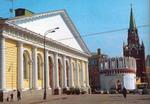 The Manege or Central Exhibition Hall is located on the Manege square. The Manege building is distinguished by the conceptual breadth and somehow restrained strength. The Manege or Central Exhibition Hall is located on the Manege square. The Manege building is distinguished by the conceptual breadth and somehow restrained strength.
This is one of the best architectural monuments of the late classicism. It was constructed in 1817 honoring the 5th anniversary of the victory in the Patriotic War of 1812. The building was designed by engineers A.Karbonie, A.Betankur, A.Kashperov and architects O.Bove and A.Monferrane.
The clear-cut rhythm of Doric columns makes one forget about the enormous length of the building. The repeated depiction of military regalia on its fronts is a tribute to the victory of Russian arms in the Patriotic War of 1812 that was common for those years. However, it also had a specific memorial meaning: the Manege opening ceremony was marked by the parade of triumphant troops returning from Paris after the war was over.
Bove decided to leave the Manege gigantic pediments unoccupied although Moscow's governor-general demanded to fill them up with sculptural compositions. But the town-planner did resist that order - it was Bove who was determining the city's face and, according to his plan, the composition center of the Manege square should be at the site of the nearby university building.
The vast hall of about 7500 square meters (166 m long and 45 m wide) was overlapped by the suspended wooden roofing that was brilliantly designed and did not have a single supporting column. In those years such a construction was considered wonder of engineering.
Originally the Manege was meant to become the site of holding parades by troops of the Moscow garrison and cavalry units' exercises.
From 1831 on it became used for other purposes as well, particularly for exhibitions, public festivities, concerts. For example, the first all-Russian ethnographic and polytechnic exhibitions were held there and later their items formed the base of collections of the History and Polytechnic museums. The Russian music society conducted musical nights: in 1867 Artur Rubinstein and Hector Berlioz gave their concert there with 12 thousand listeners present.
In 1940 the wooden rafters of the suspended roofing were changed for the metallic ones. In 1957, after the regular reconstruction works had been completed, the Central Exhibition Hall with the total show space of 6500 square meters was opened in the Manege building and since then various exhibitions have been taking place there.
District: Downtown
Address: 1, Manezhnaya Sq., Moscow
Underground: Biblioteka named after Lenin
|













 Culture and Art
Culture and Art  Architecture
Architecture  Masterpieces of Russian architecture
Masterpieces of Russian architecture